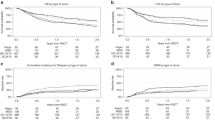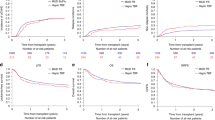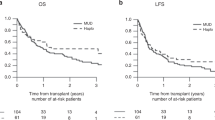Abstract
We prospectively compared two strategies of allogeneic PBSCT from HLA-identical siblings in adults with poor-risk AML or myelodysplastic syndrome with >5% marrow blasts in an early disease status (AML or refractory anemia with excess blasts (RAEB type 2) in first remission after chemotherapy or untreated RAEB type 1). Based only on age, all consecutive patients were offered one of two specific transplant protocols. Patients ⩽50 years old received conventional high-dose conditioning with cyclophosphamide-TBI and use of CD34+-selected PBSCT (CTCD34+ group), while patients aged >50 years received a reduced-intensity conditioning (RIC) with fludarabine and oral busulphan (FB-RIC). Seventy-five patients entered the study (35 in the CTCD34+ and 39 in the FB-RIC group). The median follow-up was >4 years in both groups. The 4-year non-relapse mortality (NRM) was 19 and 20%, respectively (P=0.8). Relapse and survival were also equivalent in both groups. These results suggest that in this setting, the expected high NRM in elderly patients can be reduced with an RIC regimen.
This is a preview of subscription content, access via your institution
Access options
Subscribe to this journal
Receive 12 print issues and online access
$259.00 per year
only $21.58 per issue
Buy this article
- Purchase on Springer Link
- Instant access to full article PDF
Prices may be subject to local taxes which are calculated during checkout


Similar content being viewed by others
References
Appelbaum FR, Pearce SF . Hematopoietic cell transplantation in first complete remission versus early relapse. Best Pract Res Clin Haematol 2006; 19: 333–339.
de WT, Oosterveld M, Span B, Muus P, Schattenberg A . Stem cell transplantation for leukemias following myelodysplastic syndromes or secondary to cytotoxic therapy. Rev Clin Exp Hematol 2002; 6: 72–85.
Martino R, Iacobelli S, Brand R, Jansen T, van Biezen A, Finke J et al. Retrospective comparison of reduced-intensity conditioning and conventional high-dose conditioning for allogeneic hematopoietic stem cell transplantation using HLA-identical sibling donors in myelodysplastic syndromes. Blood 2006; 108: 836–846.
de Lima M, Giralt S . Allogeneic transplantation for the elderly patient with acute myelogenous leukemia or myelodysplastic syndrome. Semin Hematol 2006; 43: 107–117.
de Lima M, Anagnostopoulos A, Munsell M, Shahjahan M, Ueno N, Ippoliti C et al. Nonablative versus reduced-intensity conditioning regimens in the treatment of acute myeloid leukemia and high-risk myelodysplastic syndrome: dose is relevant for long-term disease control after allogeneic hematopoietic stem cell transplantation. Blood 2004; 104: 865–872.
Niederwieser D, Lange T, Cross M, Basara N, Al-Ali H . Reduced intensity conditioning (RIC) haematopoietic cell transplants in elderly patients with AML. Best Pract Res Clin Haematol 2006; 19: 825–838.
Lazarus HM, Rowe JM . Reduced-intensity conditioning for acute myeloid leukemia: is this strategy correct. Leukemia 2006; 20: 1673–1682.
Ho AY, Pagliuca A, Kenyon M, Parker JE, Mijovic A, Devereux S et al. Reduced-intensity allogeneic hematopoietic stem cell transplantation for myelodysplastic syndrome and acute myeloid leukemia with multilineage dysplasia using fludarabine, busulphan, and alemtuzumab (FBC) conditioning. Blood 2004; 104: 1616–1623.
Scott BL, Sandmaier BM, Storer B, Maris MB, Sorror ML, Maloney DG et al. Myeloablative vs nonmyeloablative allogeneic transplantation for patients with myelodysplastic syndrome or acute myelogenous leukemia with multilineage dysplasia: a retrospective analysis. Leukemia 2006; 20: 128–135.
Shimoni A, Hardan I, Shem-Tov N, Yeshurun M, Yerushalmi R, Avigdor A et al. Allogeneic hematopoietic stem-cell transplantation in AML and MDS using myeloablative versus reduced-intensity conditioning: the role of dose intensity. Leukemia 2006; 20: 322–328.
Aoudjhane M, Labopin M, Gorin NC, Shimoni A, Ruutu T, Kolb HJ et al. Comparative outcome of reduced intensity and myeloablative conditioning regimen in HLA identical sibling allogeneic haematopoietic stem cell transplantation for patients older than 50 years of age with acute myeloblastic leukaemia: a retrospective survey from the Acute Leukemia Working Party (ALWP) of the European group for Blood and Marrow Transplantation (EBMT). Leukemia 2005; 19: 2304–2312.
Martino R, Caballero MD, Simon JA, Canals C, Solano C, Urbano-Ispizua A et al. Evidence for a graft-versus-leukemia effect after allogeneic peripheral blood stem cell transplantation with reduced-intensity conditioning in acute myelogenous leukemia and myelodysplastic syndromes. Blood 2002; 100: 2243–2245.
Martino R, Perez-Simon JA, Moreno E, Queralto JM, Caballero D, Mateos M et al. Reduced-intensity conditioning allogeneic blood stem cell transplantation with fludarabine and oral busulfan with or without pharmacokinetically targeted busulfan dosing in patients with myeloid leukemia ineligible for conventional conditioning. Biol Blood Marrow Transplant 2005; 11: 437–447.
Suciu S, Mandelli F, de Witte T, Zittoun R, Gallo E, Labar B et al. Allogeneic compared with autologous stem cell transplantation in the treatment of patients younger than 46 years with acute myeloid leukemia (AML) in first complete remission (CR1): an intention-to-treat analysis of the EORTC/GIMEMAAML-10 trial. Blood 2003; 102: 1232–1240.
Brunet S, Esteve J, Berlanga J, Ribera JM, Bueno J, Marti JM et al. Treatment of primary acute myeloid leukemia: results of a prospective multicenter trial including high-dose cytarabine or stem cell transplantation as post-remission strategy. Haematologica 2004; 89: 940–949.
Munoz L, Aventin A, Villamor N, Junca J, Acebedo G, Domingo A et al. Immunophenotypic findings in acute myeloid leukemia with FLT3 internal tandem duplication. Haematologica 2003; 88: 637–645.
Greenberg P, Cox C, LeBeau MM, Fenaux P, Morel P, Sanz G et al. International scoring system for evaluating prognosis in myelodysplastic syndromes. Blood 1997; 89: 2079–2088.
Urbano-Ispizua A, Brunet S, Solano C, Moraleda JM, Rovira M, Zuazu J et al. Allogeneic transplantation of CD34+-selected cells from peripheral blood in patients with myeloid malignancies in early phase: a case control comparison with unmodified peripheral blood transplantation. Bone Marrow Transplant 2001; 28: 349–354.
Newell DJ . Intention-to-treat analysis: implications for quantitative and qualitative research. Int J Epidemiol 1992; 21: 837–841.
Sorror ML, Maris MB, Storb R, Baron F, Sandmaier BM, Maloney DG et al. Hematopoietic cell transplantation (HCT)-specific comorbidity index: a new tool for risk assessment before allogeneic HCT. Blood 2005; 106: 2912–2919.
Gray R, Wheatley K . How to avoid bias when comparing bone marrow transplantation with chemotherapy. Bone Marrow Transplant 1991; 7 (suppl 3): 9–12.
Valcarcel D, Martino R, Caballero D, Mateos MV, Perez-Simon JA, Canals C et al. Chimerism analysis following allogeneic peripheral blood stem cell transplantation with reduced-intensity conditioning. Bone Marrow Transplant 2003; 31: 387–392.
Mengis C, Aebi S, Tobler A, Dahler W, Fey MF . Assessment of differences in patient populations selected for excluded from participation in clinical phase III acute myelogenous leukemia trials. J Clin Oncol 2003; 21: 3933–3939.
Estey E, de Lima M, Tibes R, Pierce S, Kantarjian H, Champlin R et al. Prospective feasibility analysis of reduced intensity conditioning regimens (RIC) for hematopoetic stem cell transplantation (HSCT) in elderly patients with acute myeloid leukemia (AML) and high-risk myelodysplastic syndrome (MDS). Blood 2007; 109: 1395–1400.
Deschler B, de Witte T, Mertelsmann R, Lubbert M . Treatment decision-making for older patients with high-risk myelodysplastic syndrome or acute myeloid leukemia: problems and approaches. Haematologica 2006; 91: 1513–1522.
Acknowledgements
This study was performed in the setting of the CETLAM cooperative group (Grupo Cooperativo para el Estudio y Tratamiento de las Leucemias Agudas y Mielodisplasias, protocols CET-LAM-99 and CET-LAM-2003), in part with grants C03/010 and 603/008 from the Instituto de Salud Carlos III and two grants from Fundació d’Investigació Sant Pau and Fundació ‘La Caixa’ (Barcelona, Spain).
Author information
Authors and Affiliations
Corresponding author
Additional information
Specific contribution(s) of each coauthor: RM: conceived and executed the research reported in the paper, the integrity and data analysis, was involved in patient care and wrote the various versions of the manuscript. In addition, he also had the task of data management and statistical analyses. DV: collaborated in patient care, data management and the statistical analyses. All other co-authors contributed in the conception and execution of the research reported in the paper and in-patient care, and participated in writing or interpreting relevant parts of the manuscript.
Rights and permissions
About this article
Cite this article
Martino, R., Valcárcel, D., Brunet, S. et al. Comparable non-relapse mortality and survival after HLA-identical sibling blood stem cell transplantation with reduced or conventional-intensity preparative regimens for high-risk myelodysplasia or acute myeloid leukemia in first remission. Bone Marrow Transplant 41, 33–38 (2008). https://doi.org/10.1038/sj.bmt.1705879
Received:
Revised:
Accepted:
Published:
Issue Date:
DOI: https://doi.org/10.1038/sj.bmt.1705879
Keywords
This article is cited by
-
Patient-Reported Outcomes in Myelodysplastic Syndromes: the Move from Life Span to Health Span
Current Hematologic Malignancy Reports (2020)
-
Fludarabine and busulfan plus low-dose TBI as reduced intensity conditioning in older patients undergoing allogeneic hematopoietic cell transplant for myeloid malignancies
Annals of Hematology (2018)
-
Reduced intensity conditioning of allogeneic hematopoietic stem cell transplantation for myelodysplastic syndrome and acute myeloid leukemia in patients older than 50 years of age: a systematic review and meta-analysis
Journal of Cancer Research and Clinical Oncology (2017)
-
Does quality of life impact the decision to pursue stem cell transplantation for elderly patients with advanced MDS?
Bone Marrow Transplantation (2016)
-
Comparison of conditioning regimens of various intensities for allogeneic hematopoietic SCT using HLA-identical sibling donors in AML and MDS with <10% BM blasts: a report from EBMT
Bone Marrow Transplantation (2013)



